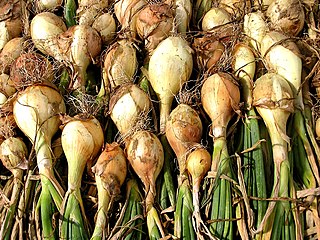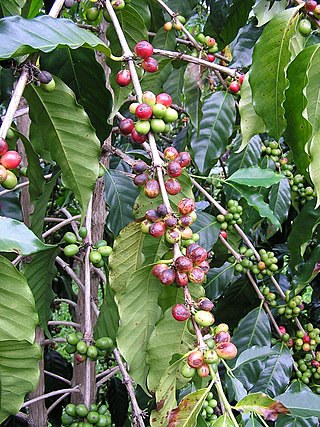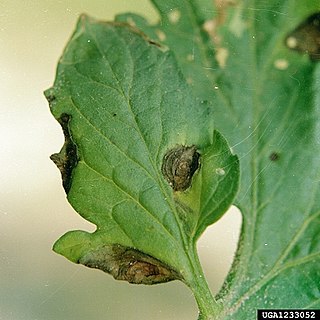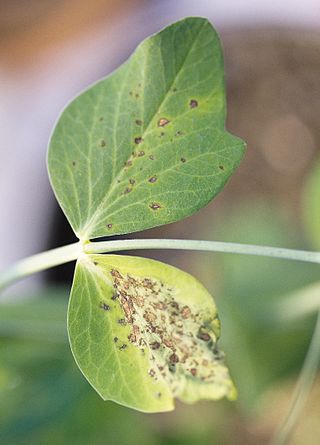Related Research Articles

White onion or Allium cepa are a cultivar of dry onion which have a distinct light and mild flavour profile. Much like red onions, they have a high sugar and low sulphur content, and thus have a relatively short shelf life. White onions are used in a variety of dishes, such as those of Mexican and European origin. Their uses in dishes often relate to their mild nature, they are often included in dishes to provide a light, fresh and sour taste to dishes and are often added uncooked to dishes such as salads.
Scald is common disease of barley in temperate regions. It is caused by the fungus Rhynchosporium commune and can cause significant yield losses in cooler, wet seasons.
Bacterial blight is a disease of barley caused by the bacterial pathogen Xanthomonas campestris pv. translucens. It has been known as a disease since the late 19th century. It has a worldwide distribution.

Covered smut of barley is caused by the fungus Ustilago hordei. The disease is found worldwide and it is more extensively distributed than either loose smut or false loose smut.

Loose smut of barley is caused by Ustilago nuda. It is a disease that can destroy a large proportion of a barley crop. Loose smut replaces grain heads with smut, or masses of spores which infect the open flowers of healthy plants and grow into the seed, without showing any symptoms. Seeds appear healthy and only when they reach maturity the following season is it clear that they were infected. Systemic fungicides are the major control method for loose smut.
Powdery mildew is a fungal disease of barley caused by Blumeria graminis f. sp. hordei. The disease has a worldwide distribution and is most damaging in cool, wet climates. The host range of the form species hordei is restricted to barley and other Hordeum species.

Mycosphaerella coffeicola is a sexually reproducing fungal plant pathogen. It is most commonly referred to as the asexual organism Cercospora coffeicola.

Pyrenophora tritici-repentis (teleomorph) and Drechslera tritici-repentis (anamorph) is a necrotrophic plant pathogen of fungal origin, phylum Ascomycota. The pathogen causes a disease originally named yellow spot but now commonly called tan spot, yellow leaf spot, yellow leaf blotch or helminthosporiosis. At least eight races of the pathogen are known to occur based on their virulence on a wheat differential set.

Diplocarpon earlianum is a species of fungus that causes disease in strawberry plants called strawberry leaf scorch. The disease overwinters in plant debris and infects strawberry plants during the spring season when it is wet. The five main methods to reduce strawberry leaf scorch include: irrigation techniques, crop rotation, planting resistant and disease-free seeds, fungicide use, and sanitation measures. Control of strawberry leaf scorch is important because it is responsible for the majority of disease in strawberries. Diplocarpon earliana affects the fruit quality and yield of the strawberry crop. Losses range from negligible to severe depending on numerous epidemiological factors including cultivar susceptibility, type of cropping system, and weather conditions

Ascochyta is a genus of ascomycete fungi, containing several species that are pathogenic to plants, particularly cereal crops. The taxonomy of this genus is still incomplete. The genus was first described in 1830 by Marie-Anne Libert, who regarded the spores as minute asci and the cell contents as spherical spores. Numerous revisions to the members of the genus and its description were made for the next several years. Species that are plant pathogenic on cereals include, A. hordei, A. graminea, A. sorghi, A. tritici. Symptoms are usually elliptical spots that are initially chlorotic and later become a necrotic brown. Management includes fungicide applications and sanitation of diseased plant tissue debris.

Alternaria solani is a fungal pathogen that produces a disease in tomato and potato plants called early blight. The pathogen produces distinctive "bullseye" patterned leaf spots and can also cause stem lesions and fruit rot on tomato and tuber blight on potato. Despite the name "early," foliar symptoms usually occur on older leaves. If uncontrolled, early blight can cause significant yield reductions. Primary methods of controlling this disease include preventing long periods of wetness on leaf surfaces and applying fungicides. Early blight can also be caused by Alternaria tomatophila, which is more virulent on stems and leaves of tomato plants than Alternaria solani.

Ascochyta pisi is a fungal plant pathogen that causes ascochyta blight on pea, causing lesions of stems, leaves, and pods. These same symptoms can also be caused by Ascochyta pinodes, and the two fungi are not easily distinguishable.

Cercospora sojina is a fungal plant pathogen which causes frogeye leaf spot of soybeans. Frog eye leaf spot is a major disease on soybeans in the southern U.S. and has recently started to expand into the northern U.S. where soybeans are grown. The disease is also found in other soybean production areas of the world.
Soil-borne wheat mosaic virus is a rod-shaped plant pathogen that can cause severe stunting and mosaic in susceptible wheat, barley and rye cultivars. The disease has often been misdiagnosed as a nutritional problem, but this has actually allowed in part for the fortuitous visual selection by breeding programs of resistant genotypes. Soil-borne wheat mosaic virus is part of the genus Furovirus. Members of this genus are characterized by rigid rod-shaped particles and positive sense RNA genomes consisting of two molecules that are packaged into separate particles that code for either replication, mobility, structure or defense against the host. The virus is spread by a fungal-like protist, Polymyxa graminis, whose asexual secondary and sexual primary cycles help the virus spread. The disease produces secondary symptoms from the root cell infection. The disease is a serious contributor to loss in crop yield.

Botrytis fabae is a plant pathogen, a fungus that causes chocolate spot disease of broad or fava bean plants, Vicia faba. It was described scientifically by Mexican-born Galician microbiologist Juan Rodríguez Sardiña in 1929.
This article summarizes different crops, what common fungal problems they have, and how fungicide should be used in order to mitigate damage and crop loss. This page also covers how specific fungal infections affect crops present in the United States.

Grey leaf spot (GLS) is a foliar fungal disease that affects maize, also known as corn. GLS is considered one of the most significant yield-limiting diseases of corn worldwide. There are two fungal pathogens that cause GLS: Cercospora zeae-maydis and Cercospora zeina. Symptoms seen on corn include leaf lesions, discoloration (chlorosis), and foliar blight. Distinct symptoms of GLS are rectangular, brown to gray necrotic lesions that run parallel to the leaf, spanning the spaces between the secondary leaf veins. The fungus survives in the debris of topsoil and infects healthy crops via asexual spores called conidia. Environmental conditions that best suit infection and growth include moist, humid, and warm climates. Poor airflow, low sunlight, overcrowding, improper soil nutrient and irrigation management, and poor soil drainage can all contribute to the propagation of the disease. Management techniques include crop resistance, crop rotation, residue management, use of fungicides, and weed control. The purpose of disease management is to prevent the amount of secondary disease cycles as well as to protect leaf area from damage prior to grain formation. Corn grey leaf spot is an important disease of corn production in the United States, economically significant throughout the Midwest and Mid-Atlantic regions. However, it is also prevalent in Africa, Central America, China, Europe, India, Mexico, the Philippines, northern South America, and Southeast Asia. The teleomorph of Cercospora zeae-maydis is assumed to be Mycosphaerella sp.

Ascochyta blights occur throughout the world and can be of significant economic importance. Three fungi contribute to the ascochyta blight disease complex of pea. Ascochyta pinodes causes Mycosphaerella blight. Ascochyta pinodella causes Ascochyta foot rot, and Ascochyta pisi causes Ascochyta blight and pod spot. Of the three fungi, Ascochyta pinodes is of the most importance. These diseases are conducive under wet and humid conditions and can cause a yield loss of up to fifty percent if left uncontrolled. The best method to control ascochyta blights of pea is to reduce the amount of primary inoculum through sanitation, crop-rotation, and altering the sowing date. Other methods—chemical control, biological control, and development of resistant varieties—may also be used to effectively control ascochyta diseases.
Bacterial leaf streak (BLS), also known as black chaff, is a common bacterial disease of wheat. The disease is caused by the bacterial species Xanthomonas translucens pv. undulosa. The pathogen is found globally, but is a primary problem in the US in the lower mid-south and can reduce yields by up to 40 percent.[6] BLS is primarily seed-borne and survives in and on the seed, but may also survive in crop residue in the soil in the off-season. During the growing season, the bacteria may transfer from plant to plant by contact, but it is primarily spread by rain, wind and insect contact. The bacteria thrives in moist environments, and produces a cream to yellow bacterial ooze, which, when dry, appears light colored and scale-like, resulting in a streak on the leaves. The invasion of the head of wheat causes bands of necrotic tissue on the awns, which is called Black Chaff.[14] The disease is not easily managed, as there are no pesticides on the market for treatment of the infection. There are some resistant cultivars available, but no seed treatment exists. Some integrated pest management (IPM) techniques may be used to assist with preventing infection although, none will completely prevent the disease.[2]
References
- 1 2 Mathre, D.E. (1997). Compendium of barley diseases. American Phytopathological Society. pp. 120 pp. ISBN 0-89054-180-9.
- ↑ Martens, J.W.; W.L. Seaman; T.G. Atkinson (1984). Diseases of field crops in Canada. Canadian Phytopathological Society. pp. 160 pp. ISBN 0-9691627-0-7.